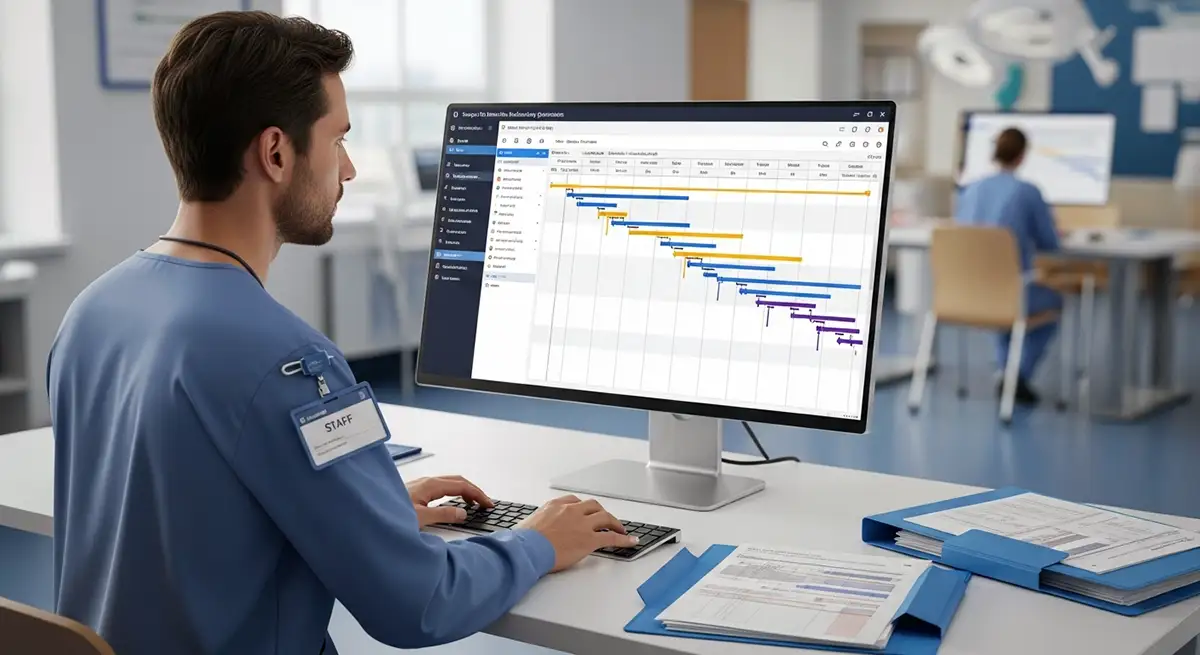
AI Hospital Workflow Optimization: Use Cases that Deliver ROI
In today's healthcare landscape, organizations are increasingly turning to technological advancements to improve their operations. One of the most promising developments is AI hospital workflow optimization. This approach leverages artificial intelligence to streamline processes, enhance patient care, and ultimately achieve significant returns on investment (ROI). In this article, we will explore the concept of AI hospital workflow optimization, examine its benefits, discuss implementation strategies, outline best practices, and provide real-world examples of its application.
Understanding AI Hospital Workflow Optimization
What is AI Hospital Workflow Optimization?
AI hospital workflow optimization refers to the integration of artificial intelligence technologies into the operational processes of healthcare facilities. This optimization aims to enhance efficiency, improve patient outcomes, and reduce costs through data-driven decision-making and automation. By harnessing the power of AI, hospitals can analyze vast amounts of data, identify inefficiencies, and implement solutions that streamline workflows.
Key Components of AI in Hospital Workflows
To effectively deploy AI hospital workflow optimization, it is crucial to understand its key components. These include:
- Data Analytics: AI systems analyze historical and real-time data to identify patterns and insights that can inform decision-making.
- Automation: Routine tasks, such as scheduling and administrative functions, can be automated, freeing up staff to focus on patient care.
- Predictive Analytics: By forecasting patient needs and operational demands, AI can help hospitals allocate resources more effectively.
- Natural Language Processing (NLP): This technology enables machines to understand and interpret human language, improving communication and documentation processes.
- Machine Learning: Algorithms that learn from data enable continuous improvement in workflows by adapting to changing patterns and demands.
Understanding these components is essential for healthcare organizations looking to leverage AI in their operations.
Benefits of AI Hospital Workflow Optimization
Improved Efficiency and Productivity
One of the primary benefits of AI hospital workflow optimization is improved efficiency. By automating repetitive tasks and streamlining processes, healthcare providers can reduce wait times and enhance productivity. For instance, AI can significantly speed up patient admissions by automating data entry and verification, allowing healthcare professionals to allocate their time to more critical functions. This not only improves the patient experience but also leads to a more efficient use of resources.
Enhanced Patient Care and Outcomes
AI hospital workflow optimization directly impacts patient care. With the ability to analyze patient data and predict needs, healthcare providers can offer more personalized treatment plans. For example, AI can identify patients at risk of complications based on historical data, enabling proactive interventions. This focus on preventive care and personalized treatment leads to better health outcomes and increased patient satisfaction.
Cost Savings and ROI
Implementing AI hospital workflow optimization can lead to significant cost savings. By reducing inefficiencies, decreasing the need for overtime staffing, and improving resource allocation, hospitals can lower operational costs. Moreover, the enhanced patient care resulting from optimized workflows can lead to fewer readmissions and better health outcomes, ultimately improving the financial performance of the organization. The ROI from AI implementations can be substantial, making it a compelling investment for healthcare facilities.
How to Implement AI Hospital Workflow Optimization
Assessing Current Workflow Challenges
The first step in implementing AI hospital workflow optimization is a thorough assessment of current workflows. Healthcare organizations should identify pain points, bottlenecks, and areas where inefficiencies are prevalent. Engaging with staff at all levels can provide valuable insights into the challenges faced in daily operations. This assessment serves as the foundation for determining where AI can have the most significant impact.
Selecting the Right AI Tools and Technologies
Once current workflow challenges have been identified, the next step is selecting the appropriate AI tools and technologies. Healthcare organizations should consider solutions that address their specific needs and priorities. This may involve partnering with technology vendors to find customizable AI solutions that seamlessly integrate with existing systems. A careful selection process ensures that the chosen tools will effectively support the hospital's unique workflow requirements.
Training Staff and Ensuring Buy-In
For AI hospital workflow optimization to be successful, it is essential to train staff and secure their buy-in. Employees must understand the benefits of AI and how it will enhance their roles rather than replace them. Providing comprehensive training programs can help alleviate concerns and foster a culture of innovation within the organization. Engaging staff in the implementation process encourages collaboration and helps identify potential issues early on.
AI Hospital Workflow Optimization Best Practices
Data Management and Integration
Effective data management is crucial for AI hospital workflow optimization. Healthcare organizations should ensure that their data is accurate, complete, and accessible to AI systems. This may involve integrating various data sources, such as electronic health records (EHR), billing systems, and lab results, into a centralized platform. By maintaining high-quality data, hospitals can maximize the effectiveness of their AI applications.
Continuous Monitoring and Improvement
AI hospital workflow optimization is not a one-time effort; it requires continuous monitoring and improvement. Organizations should establish key performance indicators (KPIs) to measure the effectiveness of AI implementations. Regularly reviewing these metrics allows hospitals to identify areas for further optimization and make data-driven adjustments to their workflows. This commitment to ongoing improvement ensures that the benefits of AI are sustained over time.
Collaboration Between Departments
Collaboration between departments is essential for successful AI hospital workflow optimization. Different departments often have unique workflows and challenges, and effective communication can help identify opportunities for improvement. Encouraging cross-departmental collaboration fosters a holistic approach to workflow optimization, ensuring that AI solutions benefit the entire organization rather than isolated segments.
AI Hospital Workflow Optimization Examples
Use Case 1: Streamlining Patient Admissions
One of the most impactful applications of AI hospital workflow optimization is in streamlining patient admissions. By automating the registration process, AI systems can quickly verify patient information, reducing wait times and enhancing the overall experience. For example, an AI-powered chatbot can assist patients in completing their registration forms online, allowing for a smoother transition upon arrival at the hospital.
Use Case 2: Optimizing Scheduling and Resource Allocation
AI can also optimize scheduling and resource allocation within hospitals. By analyzing historical data and current demand, AI systems can predict patient volumes and adjust staffing levels accordingly. This ensures that hospitals are adequately staffed during peak times while reducing excess staffing during slower periods. The result is a more efficient use of resources and improved patient care.
Use Case 3: Enhancing Telemedicine Services
As telemedicine continues to grow, AI hospital workflow optimization can enhance these services significantly. AI tools can assist in triaging patients, identifying those who require immediate attention, and scheduling virtual appointments accordingly. This not only improves access to care but also ensures that healthcare providers can manage their time effectively, providing high-quality care to patients regardless of location.
Future Trends in AI Hospital Workflow Optimization
The Role of Machine Learning and Predictive Analytics
The future of AI hospital workflow optimization will increasingly involve machine learning and predictive analytics. As AI systems become more sophisticated, they will be able to analyze larger datasets and offer even more accurate predictions. This will empower healthcare organizations to make proactive, data-driven decisions that enhance patient care and operational efficiency.
Integration with IoT and Smart Devices
The integration of AI with the Internet of Things (IoT) and smart devices is another trend shaping the future of hospital workflows. Smart devices can collect real-time data on patient health, which AI can analyze to provide insights into patient conditions. This integration will facilitate more responsive and personalized care, allowing healthcare providers to intervene before issues escalate.
Ethical Considerations and Patient Privacy
While the benefits of AI hospital workflow optimization are significant, there are also ethical considerations to address. Patient privacy and data security must remain a top priority as healthcare organizations implement AI solutions. Establishing clear guidelines and best practices for data handling will be essential in maintaining patient trust and compliance with regulations.
Conclusion
In summary, AI hospital workflow optimization presents a transformative opportunity for healthcare organizations to enhance efficiency, improve patient outcomes, and achieve substantial ROI. By understanding the fundamentals of AI in healthcare, recognizing its benefits, and following best practices for implementation, hospitals can position themselves at the forefront of innovation. As we look to the future, the integration of advanced technologies, including machine learning and IoT, will further elevate the potential of AI hospital workflow optimization.
The journey toward optimizing hospital workflows with AI is not merely a technological endeavor; it is a strategic initiative that requires a human-centered approach. By prioritizing collaboration, training, and continuous improvement, healthcare organizations can harness the full potential of AI to create a better future for patients and providers alike. For more insights into industry applications of AI, be sure to explore our comprehensive resources at Coriqence.







No comment yet, add your voice below!